The post All about Japanese teas first appeared on Blog Royal Tips.
]]>- Most of the teas are mechanically picked using hand-held hedge trimmer type machines or ride-on harvesting machines.
- The tea producers do not sort their tea at the end of the process; instead they sell the unsorted tea, known as ‘aracha’, to wholesalers who sort all the large batches of the teas they buy into different types which are then sold to retail outlets or international buyers.
- Teas are sold at auctions held in various parts of the country; however, unlike tea auctions held in other traditional tea producing countries, the buyers at a Japanese auction have not tasted the teas before the auction takes place; they examine the tea leaves very carefully and can ask to have them brewed if they would like to taste.
The names of Japanese teas give us a lot of information about each tea. Here is a list of the best known Japanese teas that are available in international markets.
Shincha (meaning ‘new tea’), also called Ichiban-cha (meaning ‘first tea’)
This is the very first harvest of the year. During the winter months, the plants store nutrients, minerals and amino acids such as L-theanine, so when the tea is picked in early spring (in mid to late April), the teas are wonderfully umami, sweet and smooth. Because of the very slow growth at the start of the season, only small quantities of Shincha are made each year; some Shincha teas are processed by machine and some by hand and the tea can be steamed or panned.
Sencha (meaning ‘simmered tea’)
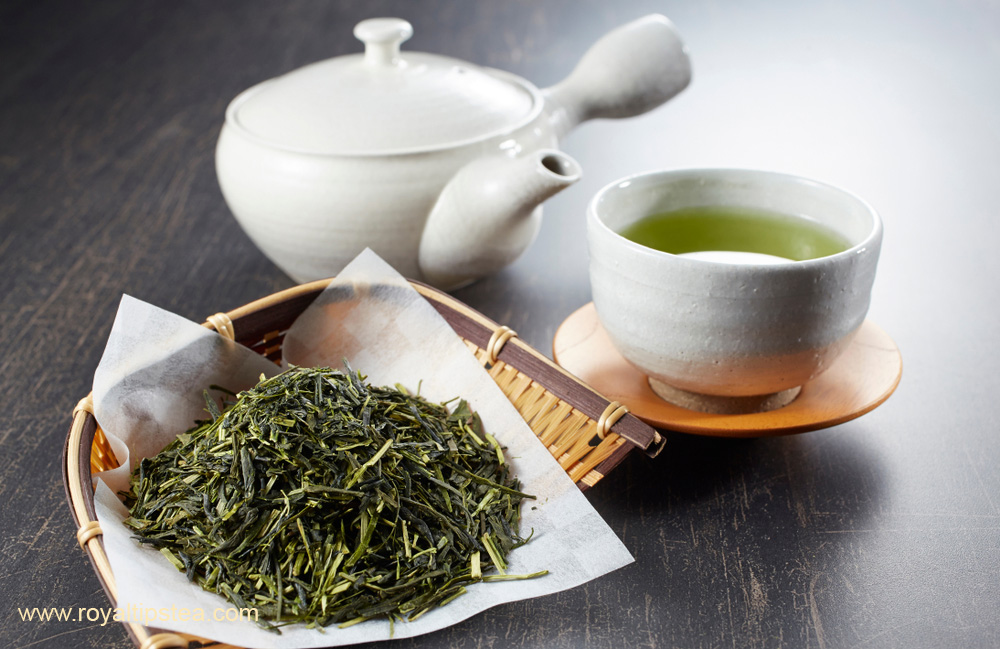
After the very limited Shincha harvest, Sencha is the first main harvest of the year and is processed by steaming, hence its name. This method of stopping oxidation by steaming the freshly picked leaves was invented in Japan in 1738. Most Sencha teas are harvested mechanically and can be processed by hand or machine; it is the most widely produced and consumed tea in Japan.
Bancha
Bancha is made from the 2nd, 3rd and 4th harvests picked in June, July, August and September, and is therefore a lower grade than Sencha. Most Bancha is harvested mechanically and can be steamed or panned.
Kabusecha (the word comes from ‘kabuseru’ meaning to cover or place on top)
Some of Japanese teas are shaded before they are picked. If the word Kabusecha appears on a packet of tea, it means it has been shaded.
There are two types of shading:
- ‘Jika-gake’ directly covers the tea bushes and cuts out approximately 50% of sunlight for between 7 and 10 days
- ‘Tana-gake’ shades the tea bushes under a framed canopy that sits several feet above the bushes; up to 90% of sunlight is cut out for 21 to 28 days before harvesting; in the past, rice straw and reeds were used to create the shade but today, modern materials which are easier to handle, are used.
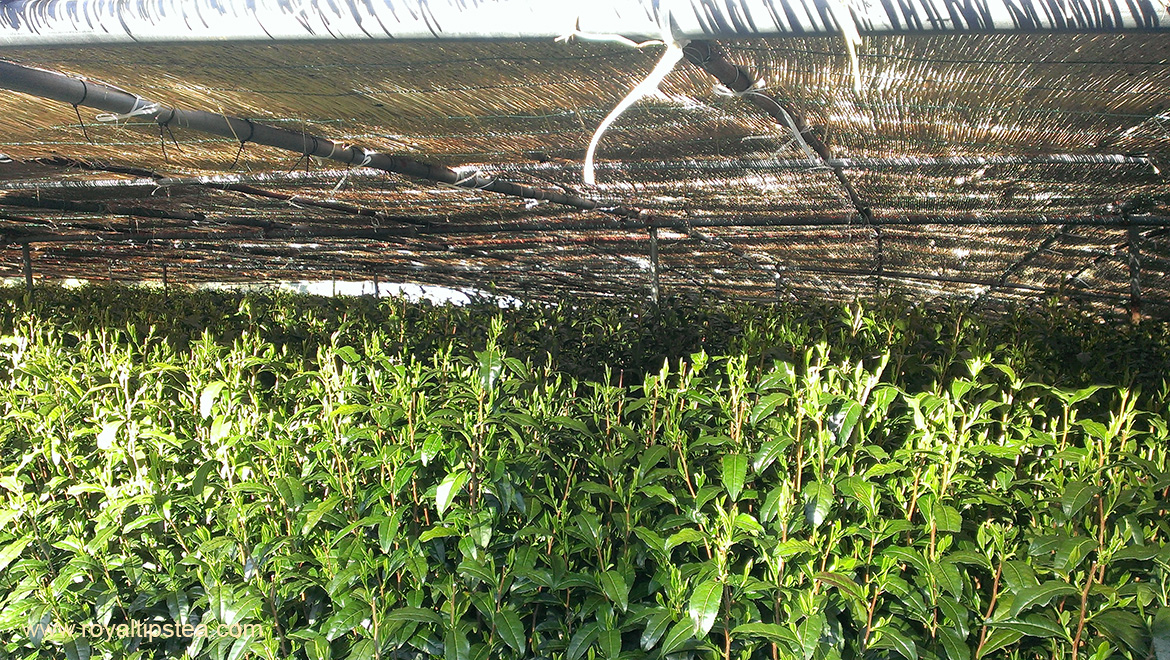
The idea of covering the bushes evolved when tea producers were trying to protect their bushes from frost; they found that if the bushes were shaded, the tea had a much sweeter, umami, more brothy taste. This is because, when tea bushes are grown in restricted sunlight, the leaves retain more of the sweet-tasting amino-acid called L-theanine, and develop fewer bitter-tasting polyphenols. The more the sunlight is cut out, and the longer the period of shading, the higher the level of L-theanine, and the sweeter and umami the taste of the tea. Shaded teas also contain more chlorophyll and caffeine.
Some Sencha teas are shaded by the ‘jika-gake’ method and are therefore a better quality, more umami and sweeter than unshaded Senchas.
Gyokuro (meaning ‘jewel dew’, ‘jade dew’ or ‘precious dew’)
Gyokuro is considered the very best of Japanese teas and is brewed with more leaf than usual to the amount of water. It is a very special tea and is drunk in small quantities from small tea bowls on special occasions. It is shaded for 21 to 28 days by the ‘tana-gake’ framed canopy method and is picked by hand in late April and early May, at the beginning of the season. It is usually processed by hand using the ‘temomi’ (meaning hand-rolled) method on a special heated table called a hoirou table.
Tencha (meaning ‘mortar’ or ‘grind’)
The name of this very special tea refers to the fact that Tencha is ground to make Matcha, the finely powdered green tea that is whisked into hot water and served at a Japanese Green Tea Ceremony. Tencha is shaded in the same way as Gyokuro and is picked, processed and dried in the early part of the season. All the stalks and fibres are removed from the dried tea so that, when it is ground to make Matcha, it is only the finest fleshy part of the leaves that are used. The grinding must be carried out very slowly in traditional stone mills and only 40 grams of matcha is made in one hour. If the grinding process is speeded up by more modern methods, there is a risk that the tea will be damaged by the build up of heat.
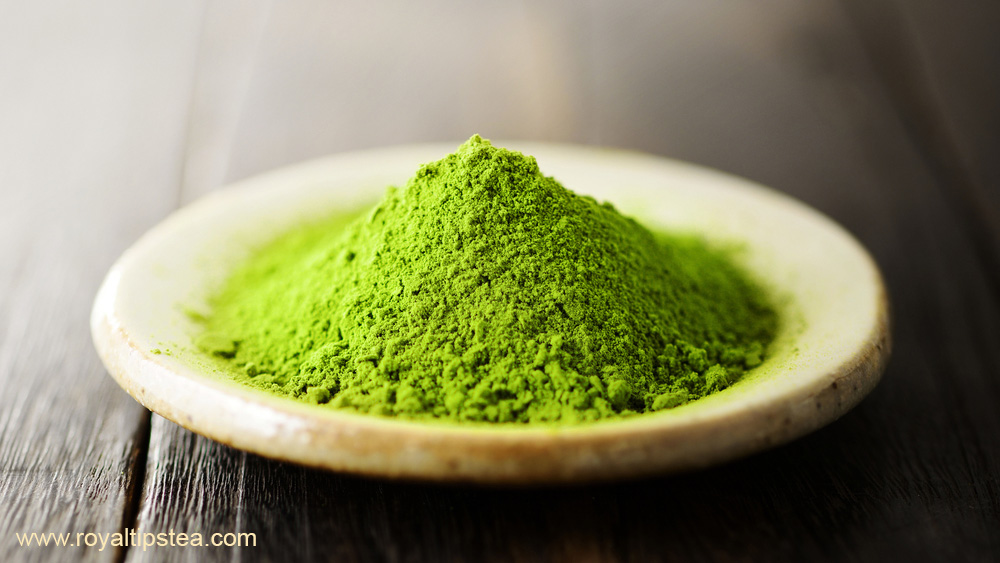
Karigane (meaning ‘cry of the wild goose’ or ‘wild goose’)
Karigane is the stems, stalks and twigs that have been separated from Gyokuro or shaded Sencha. This tea therefore has a sweet, brothy and umami character. The name comes from the fact that the small pieces of stalk that float in the tea while it is being brewed look like pieces of driftwood that provide a welcome resting place for wild geese during their migratory journey each year.
Kukicha (meaning ‘twig tea’)
Kukicha is the stems, stalks and twigs that have been separated from Sencha or Bancha leaves; it has not been shaded and is a lower grade tea.
Kamairicha (meaning ‘the tea of the pan’)
Kamairicha is a panned tea, rather than the more common steamed tea made in Japan. Japan learned how to make tea from the Chinese and so when the Chinese steamed their teas, the Japanese copied; when the Chinese started to pan their teas, Japan did the same, but then developed their own way of steaming the leaves in the 18th century and Sencha was born. Tea and knowledge about processing tea arrived into Japan from China through the south western area of Kyushu, the closest region to the Chinese coast, and it is in that region that processors have kept to their old traditional ways and still make panned green teas.
Tama Ryokucha (meaning ‘coiled green tea’; also called ‘Guricha’, meaning ‘curled tea’)
This tea can be steamed or panned and, instead of being rolled into shiny flat needles like most Japanese teas, it looks more like a hand rolled Chinese tea. Most of these teas are made in the Kyushu region
Hojicha (meaning ‘roasted tea’)
Hojicha is made from a steamed green tea (an ordinary Sencha, Bancha or Kukicha) that is roasted. This turns the leaves to a mid brown colour, gives the tea a mellow, toasty, nutty flavour and reduces the amount of caffeine in the tea.
Genmaicha (meaning ‘brown rice tea’ or toasted white rice tea’) sometimes called ‘popcorn tea’)
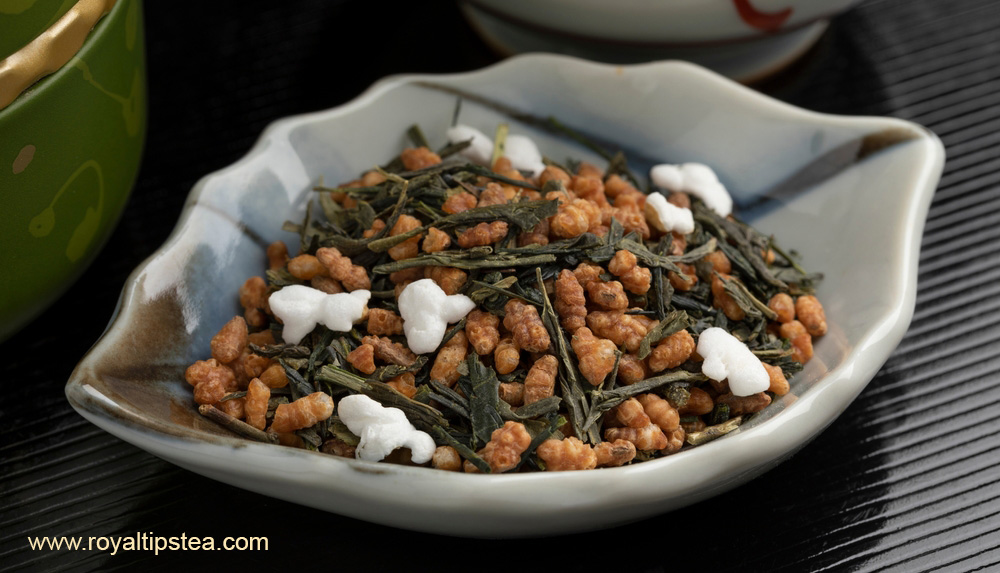
Genmaicha can be made using an ordinary Sencha, or Bancha, or Kukicha green tea to which is added roasted popped rice. ‘Genmai’can refer to brown rice or toasted white rice. One story about how it came to be made tells that in the 15th century, a servant who had stolen some rice from his master and hidden it in his sleeve, accidentally dropped some into his master’s bowl of tea. His master was very angry and is said to have immediately beheaded his servant, but then sat down to drink his tea and found that he really liked it.
Another story says that in the early 20th century, tea merchants combined their green tea with rice to make it go further during times of poverty. To make this kind of tea, the rice is soaked in water, steamed, dried, roasted and cooled. During the roasting some kernels of rice pop and so the tea is sometimes known as popcorn tea.
Matcha iri Genmaicha (also Genmaicha Matcha-Iri)
This modern mixture of Genmaicha with powdered green matcha was introduced a few years ago as a reaction to the rapidly increasing interest in matcha and its high levels of health benefits. The blend adds the pleasant nutty, toasty flavour of the Genmaicha to the slightly bitter flavour of the Matcha and makes it more palatable.
The post All about Japanese teas first appeared on Blog Royal Tips.
]]>The post Kukicha – Japanese Twig Tea first appeared on Blog Royal Tips.
]]>
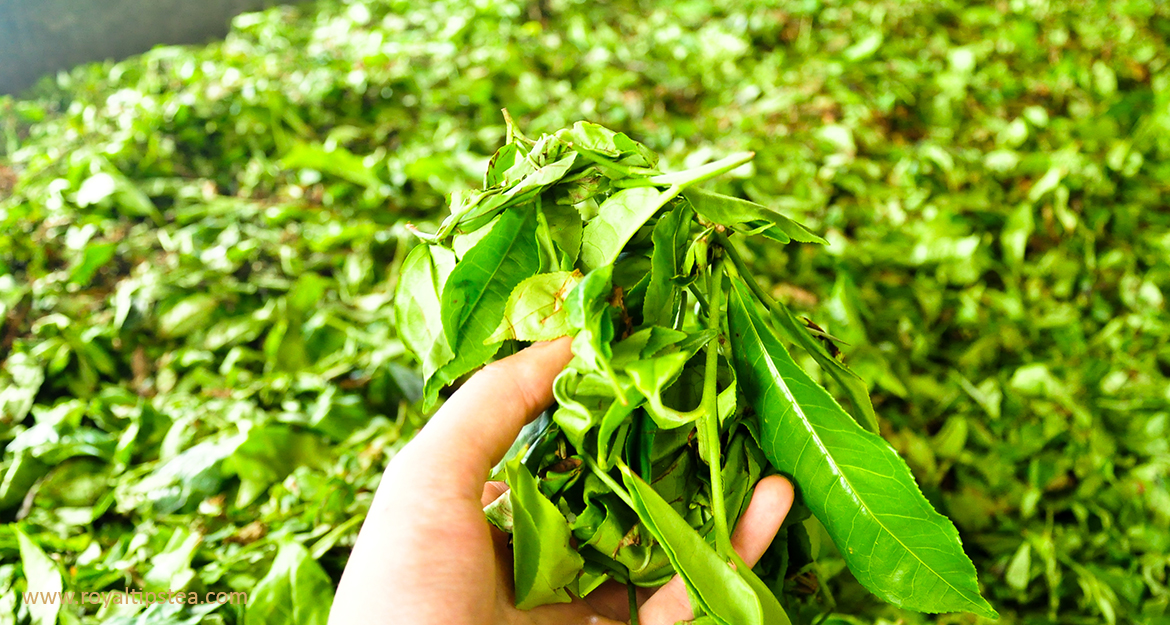
When the tea arrives at the factory door, it is first stored in cool air for a few hours and then placed in machines that are controlled by computers to steam, roll, twist, press and dry the leaves. The dried tea that comes out at the end of the production line is a mass of different sized pieces of leaf, stalks, stems, leaf veins and small, broken and dusty particles.
This unsorted tea is called ‘aracha’ and most growers and producers do not refine this crude tea but sell it in bulk through auctions to wholesalers.
The wholesalers then store the tea in chilled conditions to keep it fresh and, when it is needed at different times through the year, they refine the tea, sorting the leaf particles from the stems and stalks to give different types of tea with different names.
Sencha and Kukicha, two green tea varieties from the same harvest
‘Sencha’, for example, consists of dried leaves that are refined from ‘aracha’ made from fresh leaf shoots picked in the spring. After plucking the tea is steamed to stop oxidation. Sometimes this steaming is light and quick, for 30 to 45-seconds (called ‘asamushi’ or ‘futsumushi’), and sometimes the tea is more deeply steamed for a longer period of 1 to 2 minutes (called ‘fukamushi’). Deeper steaming gives the leaves a darker green colour and a more intense flavor.
The stalks that are separated from the leaves that make ‘sencha’ become ‘kukicha’ – ‘kuki’ means twig or stalk. Kukicha is sometimes also called ‘bocha’ (stick tea).
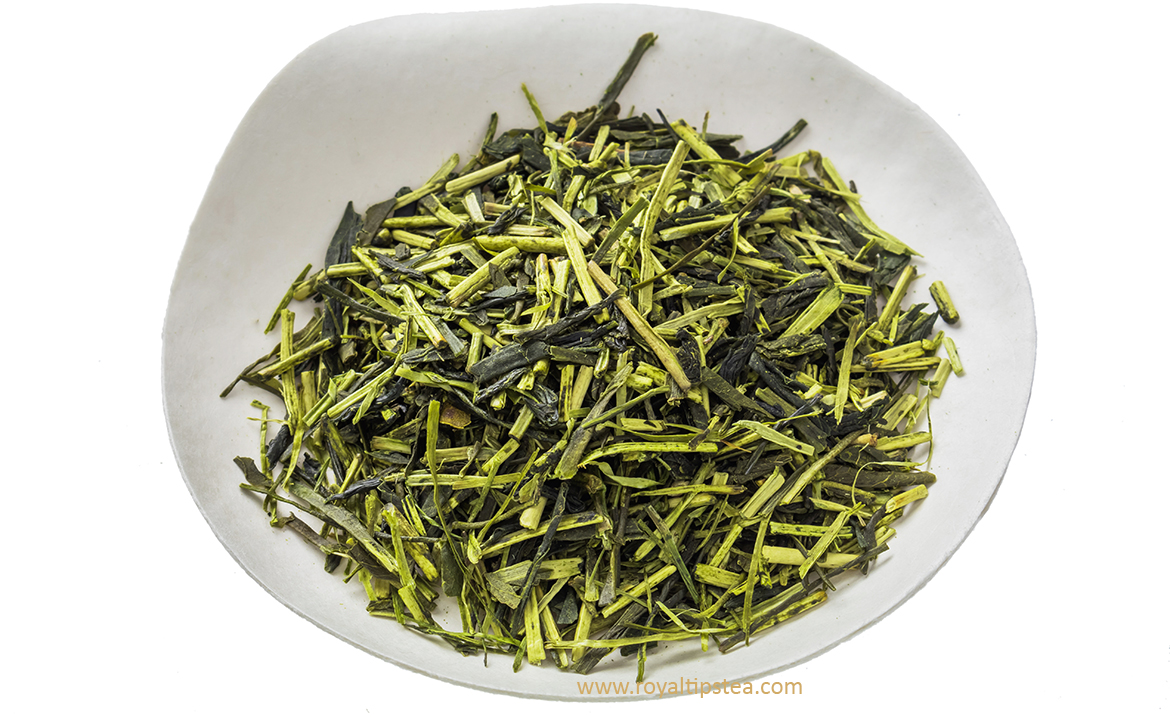
The difference between Kukicha and Karigane
The higher grade tea called ‘gyokuro’ is also made from tea shoots picked in the spring, but the difference between ‘sencha’ and ‘gyokuro’ is that the bushes used to make gyokuro are shaded for 21 days before the tea is plucked by hand.
A wooden frame is erected around and over the bushes and this then supports a special fabric that covers the bushes and cuts out 90% of the sunlight (in the past, rice straw was used instead of fabric). This shading increases the level of chlorophyll in the leaves so that they become a much darker blue-green in colour; it is also thought that more caffeine is produced in the buds and younger leaves; and fewer of the sweet L-theanine amino acids in the leaves are converted to bitter polyophenols – because of the lack of sunlight- so the tea is much sweeter and more umami in taste.
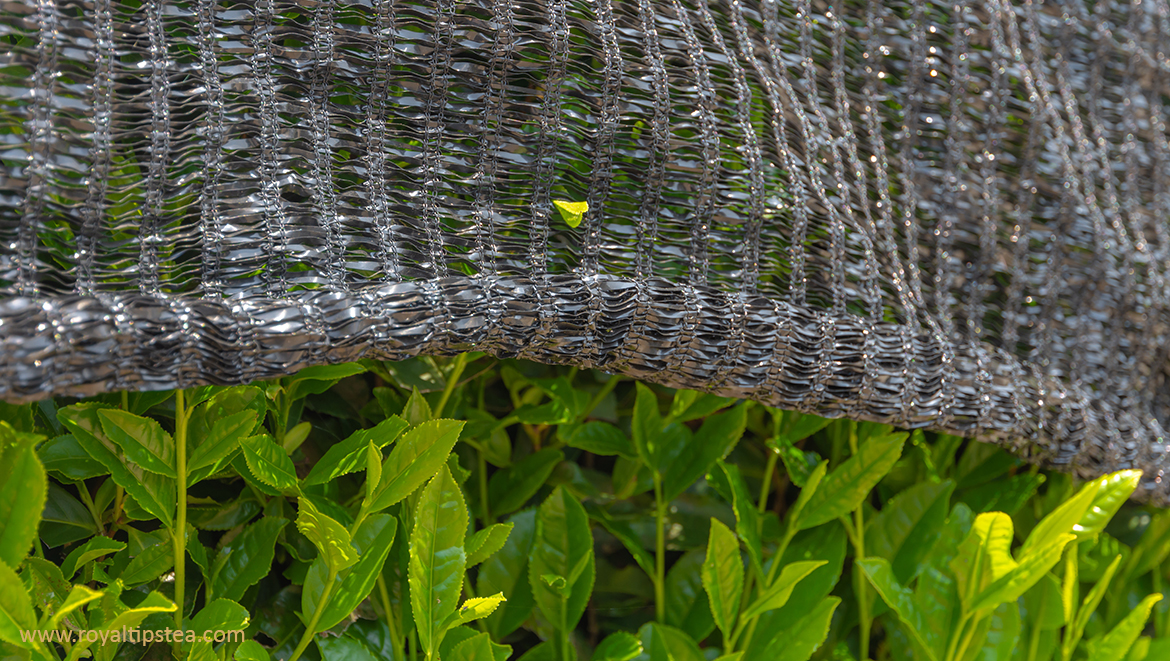
After the ‘gyokuro’ leaves have been sorted from the stalks and stems, the stalk tea is called ‘karigane’ and this is usually sweeter than ‘kukicha’ because the bushes have been shaded. ‘Karigane’ means “wild goose” and the name is from the fact that the dry stalks of tea look like the logs in the sea that migrating geese sometimes settle on to rest. Some ‘sencha’ teas are also shaded before they are picked (and are called ‘sencha kabusecha’) and both the tea and the stalks of these teas taste sweeter and more umami that unshaded teas.
Japanese teas are somewhat different from teas grown in other parts of the world. In China, different villages and provinces specialize in particular types of tea; in India, the teas from different regions have very distinct characteristics; but in Japan, producers in all the growing regions of the country make the same sorts of tea. So we can buy ‘sencha’, ‘kukicha’, ‘gyokuro’ or ‘karigane’ teas that have been made in many different parts of the country. The teas we buy usually a blend of teas made by a number of different farmers in different regions and mixed by the wholesalers who sell the teas to the retailer.
The post Kukicha – Japanese Twig Tea first appeared on Blog Royal Tips.
]]>The post Top 10 Most Famous Chinese Green Teas first appeared on Blog Royal Tips.
]]>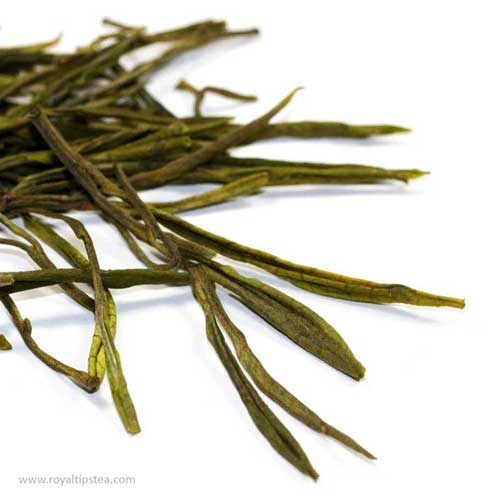
1. Anji Bai Cha (Anji White Tea)
Although the name of this exquisite tea means ‘white tea’, it is in fact a green tea. It is called white because the varietal of the tea plant used to make it produces very little chlorophyll and so the leaves are very pale. As new buds form in the early spring, they look almost white or translucent in the morning sun. The particular varietal was discovered in 1982 in Anji county, Zhejiang province, and to make the tea, young shoots of one bud and one or two leaves are picked right at the beginning of the growing season, then de-enzymed in a hot wok, rolled by hand or in a panning machine, then dried. The long, elegant, pointed dry leaves look like pine needles. The tea contains high levels of amino acids so is sweet and smooth.
2. Longjing (Dragon Well)
Long Jing is also made in the West lake region of Zhejiang province and is processed by hand using a heated wok to carry out the three important processing steps required to make green tea – panning to stop oxidation, pressing to develop flavor, drying to remove all but 2-3% of water in the leaves. Tea makers use their flat hands to move the little bud sets around the pan and, when they have finished, each tea bud is flat and shiny and yellow-green. The brew is sweet and smooth, with hints of young green vegetables such as broccoli, asparagus and pea-pods. The legend of Long Jing says that the Emperor visited the Hu Gong Temple in West Lake one day and was presented with a bowl of the tea. He was so impressed by the delicious taste and aroma that he gave ‘imperial status’ to the 18 tea bushes growing in front of the temple.
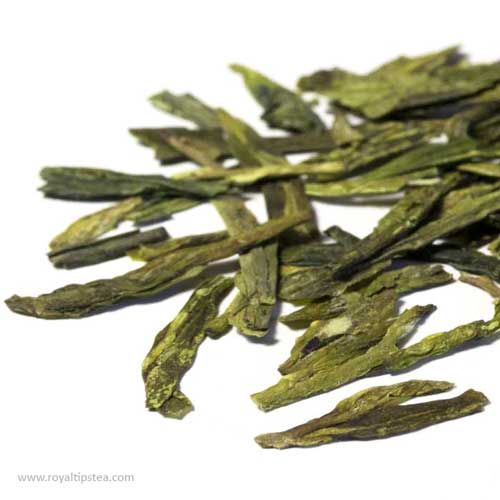
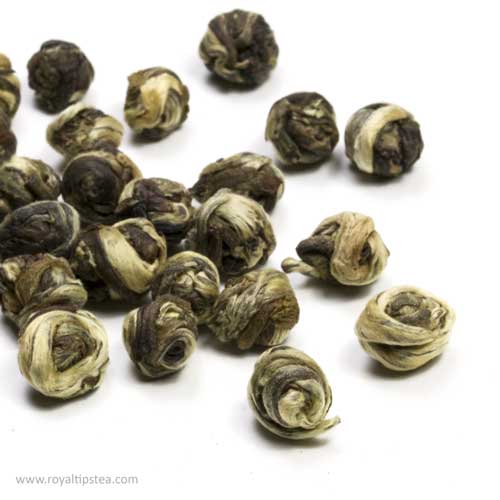
3. Jasmine Pearls
Loose Jasmine teas and Jasmine Pearls are made in Fujian province. To make loose green tea, the freshly picked tea shoots are withered for a couple of hours, then panned to stop oxidation, lightly rolled, and then dried. To make the little pearls, little shoots of one bud and 2 tiny leaves are withered briefly, panned and lightly rolled. Then two or three small shoots are gathered together and rolled by hand into neat little balls. Each pearl is then wrapped in tissue paper to hold the shape while the tea is dried. The best teas are made in the early spring and then are very carefully stored. The jasmine flowers bloom in July and August and sprigs of flowers are cut during the day, taken into the factory and, in the evening when the flowers open, all the blossoms are taken off the branches. The tea is then brought out of storage and the jasmine flowers are layered with the tea. The heaped tea and flowers can become quite hot so, during the night, so the layers of tea and flowers must be spread out to allow them to cool and then they are re-heaped. The best jasmine teas are flavoured 8 or 9 times over 8 or 9 nights, each time with a new batch of fresh jasmine blossoms.
4. Mao Jian (Jade Tips)
Mao Jian comes from Henan province and is a very tippy tea with a lovely sweet taste. The word ‘mao’ refers to the downy covering on the little buds and baby leaves; ‘jian’ refers to the shape of the leaves which are pointed and sharp. It is made in the spring and autumn but the best are those picked in early April, before the rains come, when the growth is still slow. When the weather is cool and there is very little rain, the new buds develop very slowly and so concentrate sweetness and subtle flavor in the new flush. It takes approximately 50,000 little bud shoots to make 50 grams of tea.
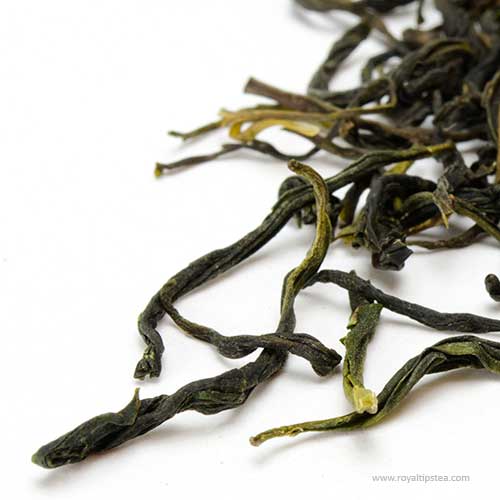
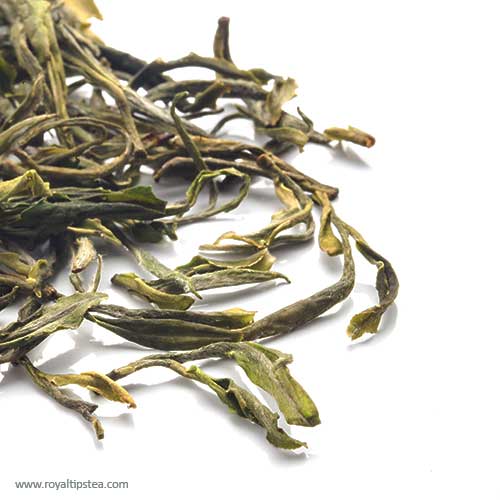
5. Huang Shan Mao Feng (Yellow Mountain Fur Peak)
This famous tea comes from Huang Shan (Yellow Mountain) in Anhui province where Keemun black tea is produced. The same varietal of the tea plant is used to make both black Keemun Mao Feng and green Mao Feng. The word ‘mao’ comes from the little white furry hairs on the outside of the tiny buds, and ‘feng’ means peak, referring to the pointed tip of the bud which looks like the peak of a mountain. The best quality teas are harvested in late March, early April, before the Qing Ming Festival of Pure Light (also called the Tomb Sweeping Festival) which falls on 4th or 5th April each year.
6. Taiping Hou Qui (Taiping Monkey King)
The story behind this rare and famous tea (only recently available in the West), tells how monkeys in the mountain area where the teas are made were very mischievous and used to damage the farmers’ crops. One day a young monkey went missing and the father monkey looked everywhere for his son, but could not find him and collapsed, tired out, in the mountains. Mr Wang Loa’r, one of the local farmers, found the exhausted father monkey and took him to his home to treat him with herbal cures. When he recovered, the father monkey was so grateful that he promised to make sure that in the future his fellow monkeys helped the farmers to pick their tea. So Mr Wang named his tea Taiping Monkey King. The tea is made from a tea varietal with very long bud and leaves and so the dried tea is almost like long green spears. The process involves panning the tea and then pressing the shoots between fine wire mesh stretched across a wooden frame. Some manufacturers use a muslin cloth to protect the leaves and, after drying, the leaves bear the criss-cross pattern of the wire mesh or muslin cloth. The tea needs to be brewed in a tall glass or large teapot because the leaves are so long.
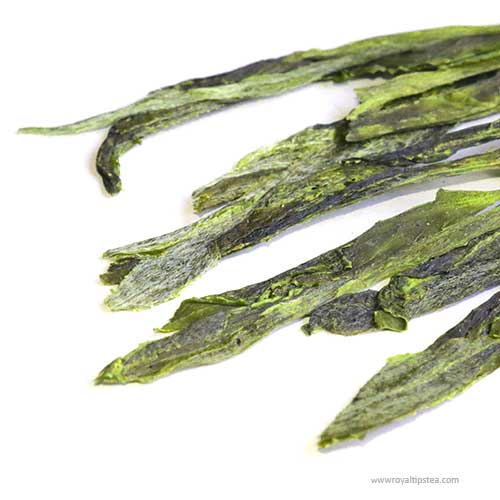
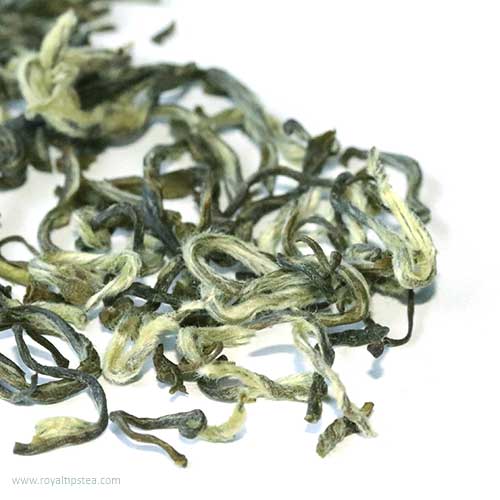
7. Bi Luo Chun (Green Snail Spring)
The tiny spirals of downy buds of this delicate tea are produced in the Dongting mountains of Jiangsu province. It takes between 14,000 and 15,000 baby shoots to make one kilo of Bi Luo Chun green tea and the names comes from the fact that the little curls of spring-picked buds look like tiny snail shells. The best teas are processed by hand and the tea masters who make them pan them in hot woks, then as the tea gently dries, they shape the leaves into small twisted curls by rolling them carefully between the palms of their hands. The silver-green leaves have a floral aroma and brew a liquor that is slightly nutty, fruity, sweet and smooth.
8. Liu An Gua Pian (Little Melon Seed)
Made in Anhui province, this tea has a long history dating back to the 8th century AD. During the Qing Dynasty (1644 to 1912) it was a tribute tea presented to the Emperor and his family. The name has become confused over time. At first called ‘sunflower seed slice’ because of the shape of the curled green leaves, the name was shortened to Guan Pian which means ‘water melon slice’. The pluckers harvest only mature open leaves approximately 4cm long, with no stems or buds. The leaves are then withered for a couple of hours, then panned and dried in wok, and as they dry they are stirred round and round with bamboo brushes which give the leaves a slightly curled shape. The tea is given a final drying in bamboo baskets that are placed repeatedly for just a few seconds each time over smouldering charcoal. The taste is quite strong, sweet and very round in the mouth, with a little astringency. The charcoal roasting gives the tea a unique depth and complexity unusual in green teas.
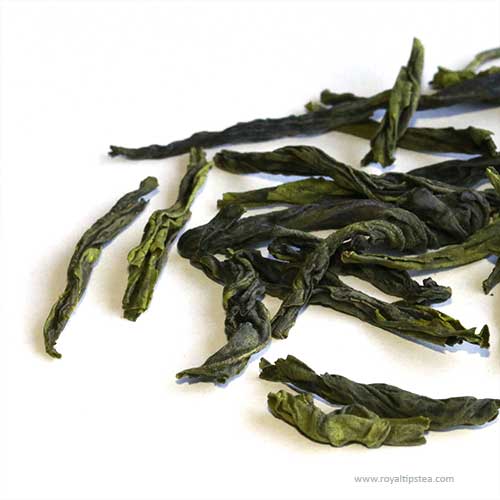
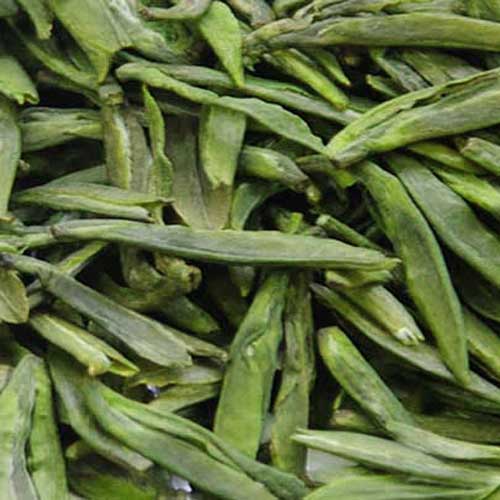
9. Zhu Ye Qing (Bamboo Green Tea)
This rare green tea is grown at altitudes of around 3000 metres on misty Emei Shan (Emei Mountain) in Sichuan province and is said to have first been made at a temple there. When a Chinese army general visited the temple in 1964, he was asked to give the tea a name and he chose the name Green Bamboo because he thought the little buds and leaves had the appearance of young bamboo leaves. The little glossy buds really look just like tiny pea pods. Plucking starts in late March and goes on until the end of April and the pickers gather little shoots of one tiny bud with a small leaf attached. The tea liquor is greeny-gold and the flavour is clean, elegant, lightly astringent and with hints of bamboo shoots, young asparagus and chestnuts.
10. Tian Mu Yun Wu (Clouds and Mist from Tian Mu Mountain)
The deep green, curly leaves of Tian Mu Yun Wu are produced in Tian Mu Mountain in Zhejiang province. Little shoots of one bud and one leaf are harvested in early April and it takes about 62,000 baby shoots to make one kilo of tea. The clouds and mist that swirl around the mountain all the time cut out a lot of the sunlight and this means that fewer of the sweet amino acids in the tea leaves are converted to bitter polyphenols, so the tea is always sweet, mild and smooth, with a pleasant lingering aftertaste. Brew the little buds in a tall glass to see them slowly absorb water and then drift elegantly down to the bottom of the glass, their pointed tips uppermost, and then rest there, waving like tiny sea anemones.
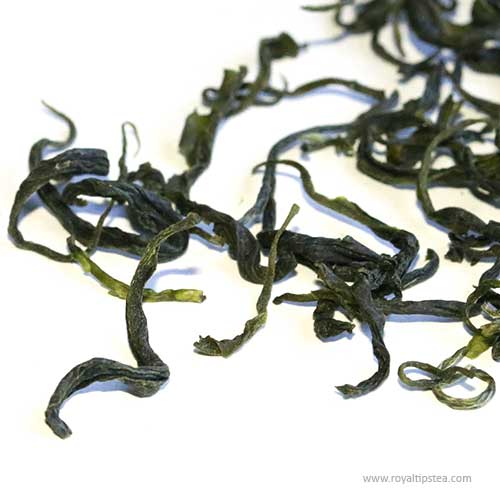
The post Top 10 Most Famous Chinese Green Teas first appeared on Blog Royal Tips.
]]>